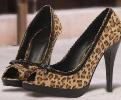The Science of Heeling
 This just in (my e-mail inbox): A scientific society has completed a study confirming that the height of a shoe's heel matters in the prevention of foot pain. Duh.
This just in (my e-mail inbox): A scientific society has completed a study confirming that the height of a shoe's heel matters in the prevention of foot pain. Duh.
The press release does not say how much money was spent on this study, the results of which are featured in the November issue of Foot & Ankle International, the official scientific journal of the American Orthopaedic Foot & Ankle Society (AOFAS), but those involved could have asked any female in my family and saved themselves the dough.
"For years orthopaedic surgeons specializing in foot and ankle care have been warning women about the perils of wearing high heels," the press release notes. "High heel wearers risk foot injury, muscle imbalance, bone deformities, knee and ankle joint problems, bunions, hammer toes and more." Hammer toes? The visuals associated with that condition should be enough to keep heels on the ground even if you don't work at a construction site.
But apparently because warning about such risks is not good enough, AOFAS recruited 21 healthy men and women, convinced them to take their shoes off, and made them stand barefoot on wooden heel blocks of varying heights. The goal of the ordeal, according to the society, was to measure participants' plantar pressure and soft-tissue thickness simultaneously using a load cell, a device that detects foot pressure, and a linear-array ultrasound transducer. If those sound like gadgets from "Star Trek the Next Generation," the results they yielded were decidedly old school.
According to the press release, "The study results revealed a significant increase in pressure on the metatarsal heads (the ends of the metatarsal bones that connect to the toes) as the heel height was raised. This increased pressure contributes to pain, callous and bony deformities." In other words, high heels hurt your feet, and the higher the heel, the more it hurts.
In the end, the study authors suggest limiting heel height to no greater than 2 centimeters (.8 inches). Also, for those who insist on digging in their heels and sticking with their elevated footwear, the authors advise using padding at the ball of the foot, which they say "can significantly reduce discomfort and risk of injury to the metatarsal heads." If that has anything to do with preventing hammer toes, using such padding's got my vote.
Posted by Ronnie Rittenberry on Dec 07, 2009